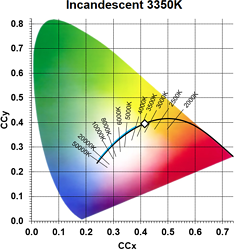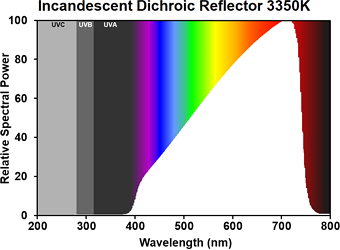
|
First MR16 Dichroic Reflector Lamp - EJM |

Earlier designs like the Sylvania Tru-Beam had a drawback, in that they were not pre-focussed. Owing to the variation in the shape of the vacuum-formed reflectors and the further variation introduced when fusing the front lens to the mirror, the rim could not be used as a datum to the optical focus point. Instead the base was used, but there existed quite some variation in the distance from this to the focal point.
GE overcame this limitation by forming a high precision pressed glass reflector, into which a single ended halogen capsule was cemented. The capsule could be focussed to a high degree of accuracy in the mirror, and the reflector rim used as the reference plane in the projector. For the first time this separated electrical and mechanical connections to the lamp - formerly both had been effected via the same base. Now it was possible to mechanically locate the lamp by its front rim, and make electrical connections via flexible cables. Consequently the location of the optical focus point was precisely fixed from lamp to lamp.
The first MR16 lamp was the EJM featured here, employing a specular cool-beam dichroic mirror. It was soon joined by EJN, differing only in its focal point. Later the EJS followed, featuring higher output with shorter life. The concept was improved with the 1971 invention of the peened reflector to reduce filament imaging, and improved again in 1975 with the invention of the multifacetted reflector.




| Manufacturer: | General Electric Co. U.S.A. | |
| Lamp Power: | 150 Watts | |
| Lamp Voltage: | 21 Volts | |
| Lamp Current: | 7.14 Amperes | |
| Cap Type: | GX5.3 | Nickel Pins |
| Bulb Type: | MR-51 | MR-16 in eighths/inch |
| Bulb Finish: | Dichroic Mirror | Vycor capsule |
| Filament Type: | CC-6 | Transverse Coiled-Coil |
| Atmosphere: | Bromine-Argon | |
| Luminous Flux: | N/A | |
| Luminous Efficacy: | N/A | |
| Luminous Intensity: | 1200 candelas | |
| Beam Distribution: | 44 mm focal dist. | |
| Colour Temperature & CRI: | CCT: 3350K | CRI: Ra 99 |
| Chromaticity Co-ordinates: | CCx: 0.406 | CCy: 0.394 |
| Rated Lifetime: | 40 hours | to 50% survival |
| Burning Position: | Universal | |
| Max. Overall Length: | 44 mm | 1 3/4" |
| Working Distance: | 38 mm | 1 1/2" |
| Factory: | Bellevue, OH | U.S.A. |
| Date of Manufacture: | 1967 December | Date Code: 48 |
| Original Value: | ||

